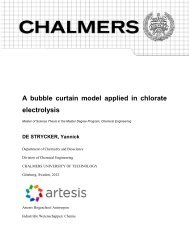impact of 4d modeling on construction planning process - Chalmers ...
impact of 4d modeling on construction planning process - Chalmers ...
impact of 4d modeling on construction planning process - Chalmers ...
You also want an ePaper? Increase the reach of your titles
YUMPU automatically turns print PDFs into web optimized ePapers that Google loves.
2 Methodology<br />
2.1 Deductive and inductive theory<br />
Bryman (2004) described two approaches for relating theory to practice which are<br />
deductive and inductive. In deductive method, the researchers observe, review and<br />
analyze existing theories; derive a hypothesis from it and validate it using empirical<br />
analysis. That is, deductive method begins with general ideas and ends with specific<br />
results, whereas in inductive method, the researchers perform a series <str<strong>on</strong>g>of</str<strong>on</strong>g> studies and<br />
observati<strong>on</strong>s to come up with findings which lead to the formati<strong>on</strong> <str<strong>on</strong>g>of</str<strong>on</strong>g> a general theory.<br />
It means that general ideas are generated from specific results in inductive approach.<br />
Theory<br />
Observati<strong>on</strong>/Findings<br />
Observati<strong>on</strong>/Findings<br />
Theory<br />
Deductive vs Inductive<br />
Figure 0-1: Deductive and Inductive approach (Bryman, 2004)<br />
2.2 Adopted Method<br />
The approach used to c<strong>on</strong>duct this thesis is deductive approach. A topic <str<strong>on</strong>g>of</str<strong>on</strong>g> interest<br />
was first selected and the hypothesis was derived for this study, that is: is 4D<str<strong>on</strong>g>modeling</str<strong>on</strong>g><br />
beneficial for c<strong>on</strong>structi<strong>on</strong> <strong>planning</strong> <strong>process</strong>? In order to validate this<br />
hypothesis, study was narrowed down to addressing specific research questi<strong>on</strong>s. To<br />
carry out the study, the quantitative methods for collecting data were mainly used.<br />
The quantitative data collecti<strong>on</strong> techniques include surveys, experiments, existing<br />
statistics and c<strong>on</strong>tent analyses (Neuman, 2006). Due to the limitati<strong>on</strong> <str<strong>on</strong>g>of</str<strong>on</strong>g> not having a<br />
company to c<strong>on</strong>duct surveys and experiments, the data was mostly collected by<br />
c<strong>on</strong>tent analysis and existing statistics.<br />
C<strong>on</strong>tent analysis is a technique to examine written informati<strong>on</strong>, c<strong>on</strong>tent or symbolic<br />
material e.g. pictures. The researcher first identifies a body <str<strong>on</strong>g>of</str<strong>on</strong>g> material to analyze, for<br />
example, books, articles, and reports or other such material. Useful relevant data is<br />
then extracted, to assist in reaching the findings. Whereas in existing statistics<br />
research, the researcher collects data from previously c<strong>on</strong>ducted experiments, surveys<br />
CHALMERS, Civil and Envir<strong>on</strong>mental Engineering, Master’s Thesis 2012:27<br />
5















